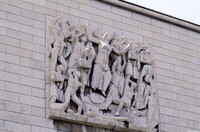Esposizione Universale of Rome (EUR) [site and area]
Pagano, Giuseppe; Piacentini, Marcello

Download1A3-FA-EUR-1-C6_cp.jpg (493.5Kb)
Date
1938-1960Description
Relief on the west INA complex, north side; In his role as Mussolini's architectural coordinator Piacentini also assumed responsibility in 1936 for the site of the Esposizione Universale of Rome (EUR), to be inaugurated in 1942. From its origins as a simple exhibition site the EUR was increasingly impelled by Piacentini into becoming a new monumental quarter of Rome. Consequently monumentality and permanence became the criteria for the competition contributions by the various artists and architects, who included Rationalists such as Pagano, Giuseppe Terragni and Adalberto Libera. Indeed they were required to forge a 'Fascist' style that was simultaneously grandiose, classical, modern and functional. Piacentini oversaw the whole programme, intervening in an increasingly dominant manner, and this led to the end of his friendship with Pagano and to his imposition of penalties on the architects responsible for the individual buildings. His pursuit of the ideal of classicism was based on the view that the exhibition site was to be a permanent symbol of the new Italian empire and therefore to be fittingly equipped with architectural associations of the ancient empire. In practice Piacentini's interventions meant frequent alterations in proportions and alignments and the introduction of columns and arches, until the original plan was unrecognizable. The site was only partly completed when the exhibition was postponed in 1940 and cancelled in 1943 following the fall of Mussolini's regime. Source: Grove Art Online; http://www.groveart.com/ (accessed 2/1/2008)
Type of Work
mixed-use development; exhibition building; sports complexSubject
architectural exteriors, rulers and leaders, City planning, Esposizione universale di Roma (1942 : Rome, Italy), Fascism, ideal cities, Novecento italiano, rationalism (architecture)
Rights
Rights Statement
Licensed for educational and research use by the MIT community only